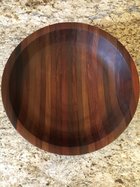I recently aquired some IPE Brazilian Walnut deck boards from a friend. As the wood is beautiful, my understanding is it's very toxic. Does anyone know anything about this wood and how safe it is for food items. Attached is a bowl I made from it. Thanks for any insight.
-
Beware of Counterfeit Woodturning Tools (click here for details) -
Johnathan Silwones is starting a new AAW chapter, Southern Alleghenies Woodturners, in Johnstown, PA. (click here for details) -
Congratulations to Keven Jesequel for "Big Leaf Maple" being selected as Turning of the Week for April 15, 2024 (click here for details) -
Welcome new registering member. Your username must be your real First and Last name (for example: John Doe). "Screen names" and "handles" are not allowed and your registration will be deleted if you don't use your real name. Also, do not use all caps nor all lower case.
You are using an out of date browser. It may not display this or other websites correctly.
You should upgrade or use an alternative browser.
You should upgrade or use an alternative browser.
IPE Brazilian Walnut
- Thread starter Skip Proctor
- Start date
Ipe, is one of those woods that people can react to. I believe it is mostly the fine dust, and once turned, it should be fine for eating out of, or very minimal risk, but not positive. General rule of thumb for woods, the stronger the scent is, the worse it is for you. Chemical warfare against bugs. I am going to be making a mortar and pestle out of some pieces I have. It does not glue up well because of all the oil in it. Very hard, and lots of silica in it.
Marketing cracks me up... It is as much of a walnut as Jatoba is cherry....
robo hippy
Marketing cracks me up... It is as much of a walnut as Jatoba is cherry....
robo hippy
Thanks Reed, great insight. I have 2 of these bowls. The one above is 19" in diameter by 5" height. I plan to sell this one in person at a Farmer's Market this Spring so the customer knows what they are getting first hand. I used Titebond 3 for the glue up. We'll see if it holds.
I have used it in a cabinetmaking project, for edgebanding and as sliced veneer. My recollection is that the material was splintery, though not as bad as wenge, and the splinters festered badly. The sanding dust was fine, oily and a bit obnoxious, though I had no toxic reaction.
Ipe describes a number of species in the Tabebuia genus and they may be mixed in commerce, so the characteristics may vary somewhat. As you have probably found, it is quite hard and heavy and dulling to tools. It is most often found air-dried for decking and although stable when dry can move a lot while getting to that point.
Many people have adverse reactions to working ipe, especially the sanding dust. Here are several links from woodworkers in the trenches ipe safety gluing ipe working w/ ipe.
A couple of memorable quotes, "The sustainability of ipe (I suspect) is due to its natural resistance to woodworkers" and
"I believe Satan's throne must be made of ipe, as it already smells like a blast from Hell."
I doubt there would be any safety concerns for the end user of an ipe bowl, but that's just a guess. As far as gluing it, thoroughly dry wood and freshly machined surfaces are a must. "Brazilian Walnut" is just a marketing ploy.
Ipe describes a number of species in the Tabebuia genus and they may be mixed in commerce, so the characteristics may vary somewhat. As you have probably found, it is quite hard and heavy and dulling to tools. It is most often found air-dried for decking and although stable when dry can move a lot while getting to that point.
Many people have adverse reactions to working ipe, especially the sanding dust. Here are several links from woodworkers in the trenches ipe safety gluing ipe working w/ ipe.
A couple of memorable quotes, "The sustainability of ipe (I suspect) is due to its natural resistance to woodworkers" and
"I believe Satan's throne must be made of ipe, as it already smells like a blast from Hell."
I doubt there would be any safety concerns for the end user of an ipe bowl, but that's just a guess. As far as gluing it, thoroughly dry wood and freshly machined surfaces are a must. "Brazilian Walnut" is just a marketing ploy.
I have used it in a cabinetmaking project, for edgebanding and as sliced veneer. My recollection is that the material was splintery, though not as bad as wenge, and the splinters festered badly. The sanding dust was fine, oily and a bit obnoxious, though I had no toxic reaction. Ipe describes a number of species in the Tabebuia genus and they may be mixed in commerce, so the characteristics may vary somewhat. As you have probably found, it is quite hard and heavy and dulling to tools. It is most often found air-dried for decking and although stable when dry can move a lot while getting to that point. Many people have adverse reactions to working ipe, especially the sanding dust. Here are several links from woodworkers in the trenches ipe safety gluing ipe working w/ ipe. A couple of memorable quotes, "The sustainability of ipe (I suspect) is due to its natural resistance to woodworkers" and "I believe Satan's throne must be made of ipe, as it already smells like a blast from Hell." I doubt there would be any safety concerns for the end user of an ipe bowl, but that's just a guess. As far as gluing it, thoroughly dry wood and freshly machined surfaces are a must. "Brazilian Walnut" is just a marketing ploy.
Good info. Thanks!
I had an outdoor patio built and a lot of it was trimmed in Ipe. The carpenters wore masks when working it. They had respiration issues with the dust.
As for gluing it, to me, you can use acetone to remove surface oils for a glue up. I would expect the oils to leach back into the joint over time. I remember having a new zero clearance insert on my table saw, and ripped some Ipe. There was a pile of resin where the blade went into the insert. Not sure how they would glue up teak, but the woods are very similar.
robo hippy
As for gluing it, to me, you can use acetone to remove surface oils for a glue up. I would expect the oils to leach back into the joint over time. I remember having a new zero clearance insert on my table saw, and ripped some Ipe. There was a pile of resin where the blade went into the insert. Not sure how they would glue up teak, but the woods are very similar.
robo hippy


